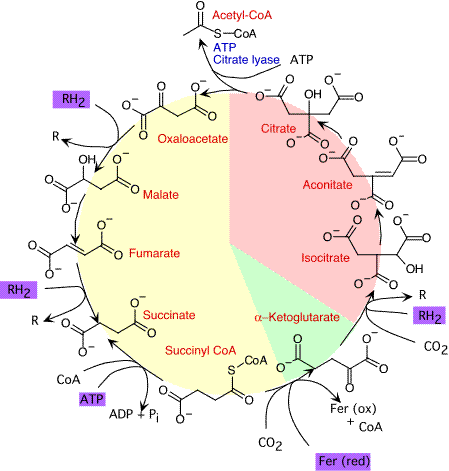博文
还原性三羧酸循环(reductive TCA cycle)
|
还原性三羧酸循环(reductive TCA cycle, rTCT)
One alternative strategy for fixing CO2 is to simply reverse the TCA cycle. Instead of breaking down acetyl CoA with the release of 2 CO2 and the generation of energy, acetyl CoA is synthesized by the incorporation of 2 CO2 and the input of 8 H (in the form of NADH and/or FADH), and 2 ATP. Some of the enzymes in the pathway are identical to the TCA cycle, but many of the energy requiring reactions are catalyzed by different enzymes. One of the key enzymes is ATP citrate lyase which cleaves citrate (6 carbons) into oxaloacetate (4 carbons) and acetyl CoA (2 carbons).
Green photosynthetic bacteria (Chlorobium limicola), some thermophillic bacteria that grow on hydrogen, (Hydrogenobacter thermophilus) and certain bacteria that grow by reducing sulfate (Desulfobacter hydrogenophilus ) have been shown to use rTCA.

Reverse Krebs cycle
From Wikipedia, the free encyclopedia
The reverse Krebs cycle (also known as the reverse tricarboxylic acid cycle, the reverse TCA cycle, or the reverse citric acid cycle) is a sequence of chemical reactions that are used by some bacteria to produce carbon compounds from carbon dioxide and water.
The reaction is basically the Citric acid cycle run in reverse. Where the Krebs cycle takes complex carbon molecules in the form of sugars and oxidizes them to CO2 and water, the reverse cycle takes CO2 and water to make carbon compounds. This process is used by some bacteria to synthesise carbon compounds, sometimes using hydrogen or sulphates as electron donors.[1][2] In this process it can be seen as an alternative to the far more common photosynthesis production of organic molecules.
The reaction is one of the possible candidates for prebiotic early earth conditions and so is of interest in the origin of life research. It has been found that some of the steps can be catalysed by minerals.[3]
References
- ^ Evans MC; Buchanan BB; Arnon DI (April 1966). "A new ferredoxin-dependent carbon reduction cycle in a photosynthetic bacterium.". Proc Natl Acad Sci U S A. 55 (4): 928–34. doi:. PMID 5219700.
- ^ Buchanan BB; Arnon DI. (1990). "A reverse KREBS cycle in photosynthesis: consensus at last.". Photosynth Res 24: 47–53. doi:. PMID 11540925.
- ^ Xiang V. Zhang; Scot T. Martin (December 2006). "Driving Parts of Krebs Cycle in Reverse through Mineral Photochemistry". J. Am. Chem. Soc. 128 (50): 16032–16033. doi:. PMID 17165745.
原始文献:
A New Ferredoxin-Dependent Carbon Reduction Cycle in a Photosynthetic Bacterium
2007年最新的评论:
Thioredoxin-an unexpeted meeting place
2004年对rTCA的深入研究
Universality in intermediary metabolism
Barbara J. Campbell, and S. Craig Cary, Abundance of Reverse Tricarboxylic Acid Cycle Genes in Free-Living Microorganisms at Deep-Sea Hydrothermal Vents (Free Full Text Article). Appl Environ Microbiol. 2004 October; 70(10): 6282–6289.
2008年论文:
A Soluble NADH-Dependent Fumarate Reductase in the Reductive Tricarboxylic Acid Cycle of Hydrogenobacter thermophilus TK-6
Akane Miura, Masafumi Kameya,* Hiroyuki Arai, Masaharu Ishii, and Yasuo Igarashi
Department of Biotechnology, The University of Tokyo, 1-1-1 Yayoi, Bunkyo-ku, Tokyo 113-8657, Japan
Received 26 May 2008/ Accepted 16 August 2008
Fumarate reductase (FRD) is an enzyme that reduces fumarate to succinate. In many organisms, it is bound to the membrane and uses electron donors such as quinol. In this study, an FRD from a thermophilic chemolithoautotrophic bacterium, Hydrogenobacter thermophilus TK-6, was purified and characterized. FRD activity using NADH as an electron donor was not detected in the membrane fraction but was found in the soluble fraction. The purified enzyme was demonstrated to be a novel type of FRD, consisting of five subunits. One subunit showed high sequence identity to the catalytic subunits of known FRDs. Although the genes of typical FRDs are assembled in a cluster, the five genes encoding the H. thermophilus FRD were distant from each other in the genome. Furthermore, phylogenetic analysis showed that the H. thermophilus FRD was located in a distinct position from those of known soluble FRDs. This is the first report of a soluble NADH-dependent FRD in Bacteria and of the purification of a FRD that operates in the reductive tricarboxylic acid cycle.
* Corresponding author. Mailing address: Department of Biotechnology, The University of Tokyo, 1-1-1 Yayoi, Bunkyo-ku, Tokyo 113-8657, Japan. Phone: (81)-3-5841-5143. Fax: (81)-3-5841-5272. E-mail: kxxbb274@ybb.ne.jp Published ahead of print on 29 August 2008.
见:http://jb.asm.org/cgi/content/abstract/190/21/7170
强烈推荐:
Universality in intermediary metabolism
+Author Affiliations
-
Communicated by Murray Gell-Mann, Santa Fe Institute, Santa Fe, NM, July 14, 2004 (received for review February 6, 2004)
Abstract
We analyze the stoichiometry, energetics, and reaction concentration dependence of the reductive tricarboxylic acid (rTCA) cycle as a universal and possibly primordial metabolic core. The rTCA reaction sequence is a network-autocatalytic cycle along the relaxation pathway for redox couples in nonequilibrium reducing environments, which provides starting organic compounds for the synthesis of all major classes of biomolecules. The concentration dependence of its reactions suggests it as a precellular bulk process. We propose that rTCA is statistically favored among competing redox relaxation pathways under early-earth conditions and that this feature drove its emergence and also accounts for its evolutionary robustness and universality. The ability to enhance the rate of core reactions creates an energetic basis for selection of subsequent layers of biological complexity.
https://blog.sciencenet.cn/blog-3533-9404.html
上一篇:Calvin Cycle——途径、发现、当时的研究方法及思路
下一篇:还原性乙酰辅酶A途径(Reductive acetyl CoA pathway)
